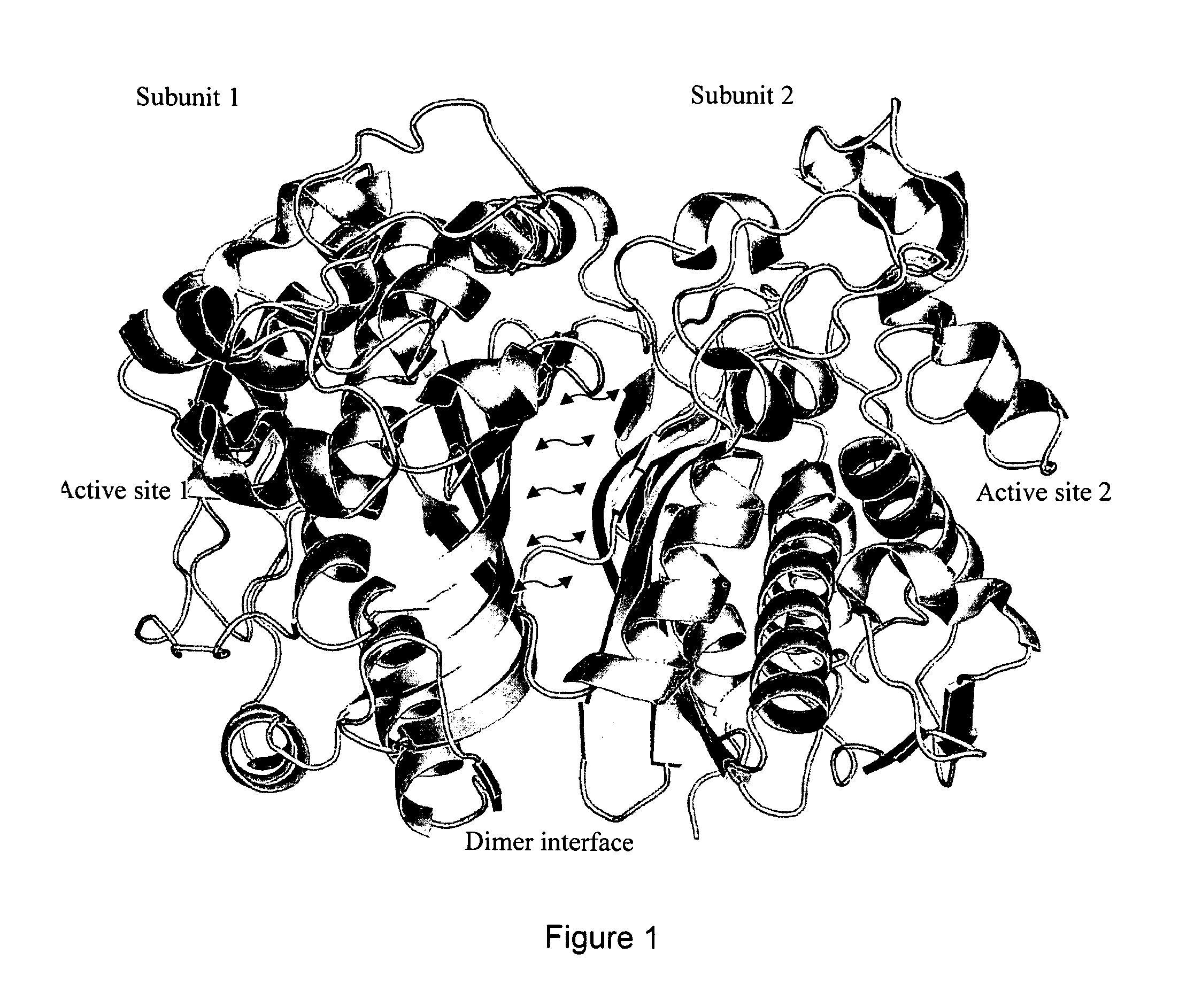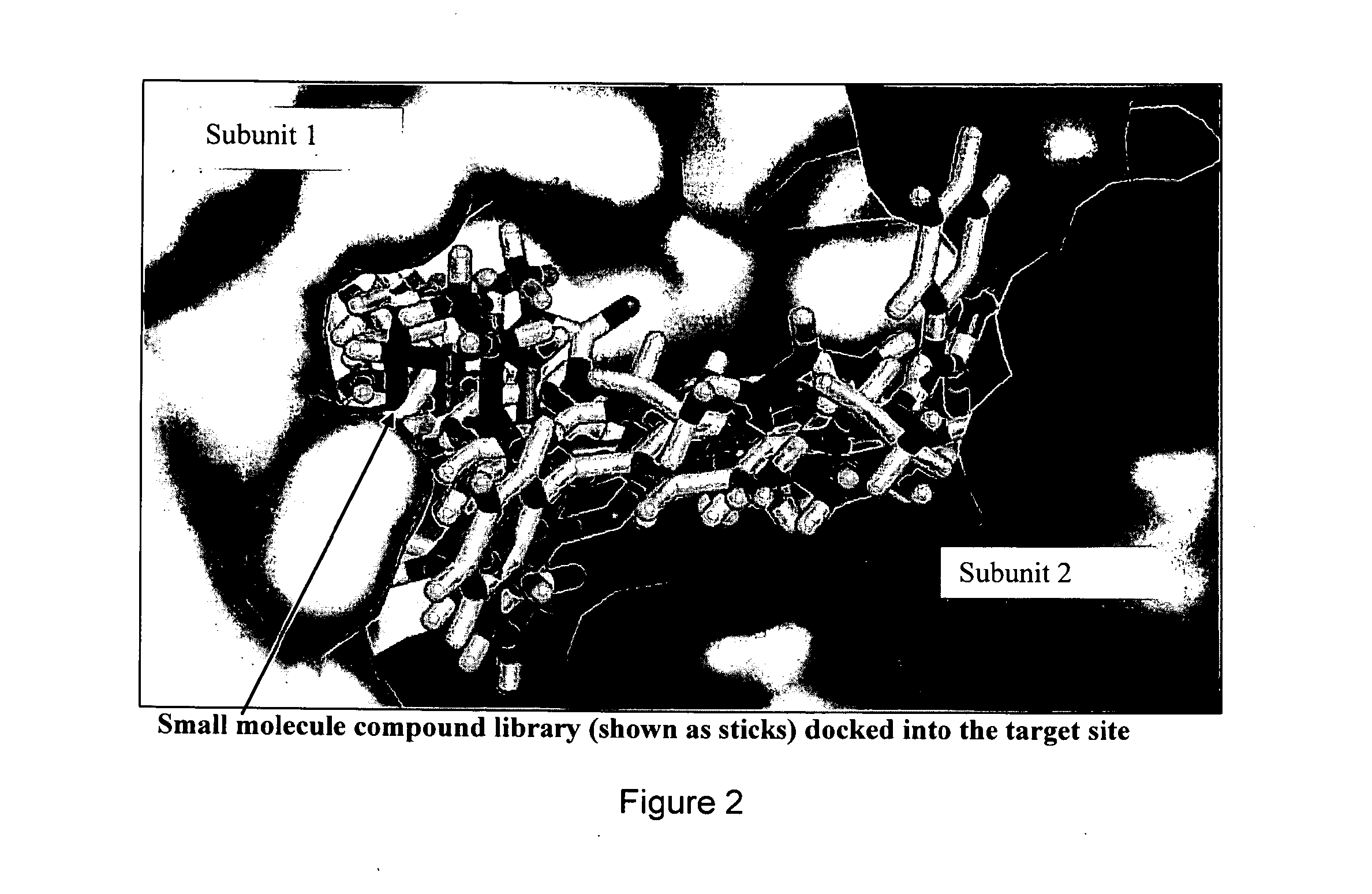Novel allosteric inhibitors of thymidylate synthase
a technology of thymidylate synthase and allosteric inhibitors, which is applied in the direction of phosphorous compound active ingredients, drug compositions, tissue culture, etc., can solve the problems of limiting clinical effectiveness, and achieve strong anti-proliferative properties and limit shearing motions
- Summary
- Abstract
- Description
- Claims
- Application Information
AI Technical Summary
Benefits of technology
Problems solved by technology
Method used
Image
Examples
example 1
Molecular Docking Studies
[0064]We have been able to identify a site at the dimer interface specific to inactive conformation of TS that is critical to TS enzymatic function. TS conformation with high asymmetry between the subunits (PDBID:1HVY) was selected as receptor target for molecular docking Protein structure was prepared by removing the heteroatoms and liganded molecules, energy minimizing in UCSF Chimera 1.5.2 and testing resulting geometries in Coot 0.6.2. National Cancer Institute (NCI) small molecule library of 139,735 compounds was extracted from ZINC and pruned to remove redundant structures and molecules with molecular weight less than 200 Da. Resulting compound library was docked (DOCK6.4) [28] [29] into selected structural pocket in 1000 orientations with flexible bond parameters enabled. To minimize noise, the compounds were selected based on averages obtained over 3 independent docking runs using different random seeds [30]. The top 1000 hits were re-scored using AM...
example 2
Thymidylate synthase purification
[0065]Recombinant human Thymidylate synthase was purified according to published protocol [31]. Briefly, 5 mL of overnight E. coli M15 culture transformed with a vector carrying His-tagged recombinant human TS was inoculated with one liter of Luria-Bertrani broth, containing 100 μg / mol of ampicillin, and was left growing in shaking incubator at 37° C. for 4.5 hours. Cells were harvested by centrifugation at 4000 rpm at 4 C and resuspended in a buffer that consisted of 20 mMKH2PO4, 30 mM NaCl supplemented with protease inhibitors. Cells were lysed by six thirty-second sonication pulses in ice bath. Cell lysates were cleared by centrifugation at 11000 rpm for lhr at 4 C. Raw lysate was loaded at room temperature onto Hi-Trap Ni-affinity column and washed with 5 bed volumes of 20 mM imidazole, 20 mM KH2PO4, pH 7.4 on AkTA-FPLC at a flow rate of 0.5 mL / min. His-tagged TS was obtained by linear gradient elution (20 mM-500 mM imidazole) at a flow rate of 0...
example 3
In Vitro Enzymatic Assays of Inhibitor Activity
[0066]Effects of top-scoring compounds on TS activity in vitro were measured using a previously described spectrophotometric assay with minor modifications [32]. Specifically, assay mix consisted of 50 mM TES, 25 mM MgCl2, 6.5 mM HCOH, 1.0 mM EDTA, 75 mM BME, 150 μM THF and 450 μM dUMP. Full-length human recombinant TS with N-terminal His-tag was purified in our laboratory and combined with 10 μM candidate compounds in 96-well plates at room temperature (25° C.). Effects of the compounds on kinetic parameters were measured at 37° C. under saturating substrate conditions by monitoring change in absorbance at 340 nm at 15 second intervals for 15 minutes. The enzyme concentration (0.5-1.0 ug / mL) was used throughout all kinetics experiments.
PUM
| Property | Measurement | Unit |
|---|---|---|
| Selectivity | aaaaa | aaaaa |
Abstract
Description
Claims
Application Information
 Login to View More
Login to View More - R&D
- Intellectual Property
- Life Sciences
- Materials
- Tech Scout
- Unparalleled Data Quality
- Higher Quality Content
- 60% Fewer Hallucinations
Browse by: Latest US Patents, China's latest patents, Technical Efficacy Thesaurus, Application Domain, Technology Topic, Popular Technical Reports.
© 2025 PatSnap. All rights reserved.Legal|Privacy policy|Modern Slavery Act Transparency Statement|Sitemap|About US| Contact US: help@patsnap.com



